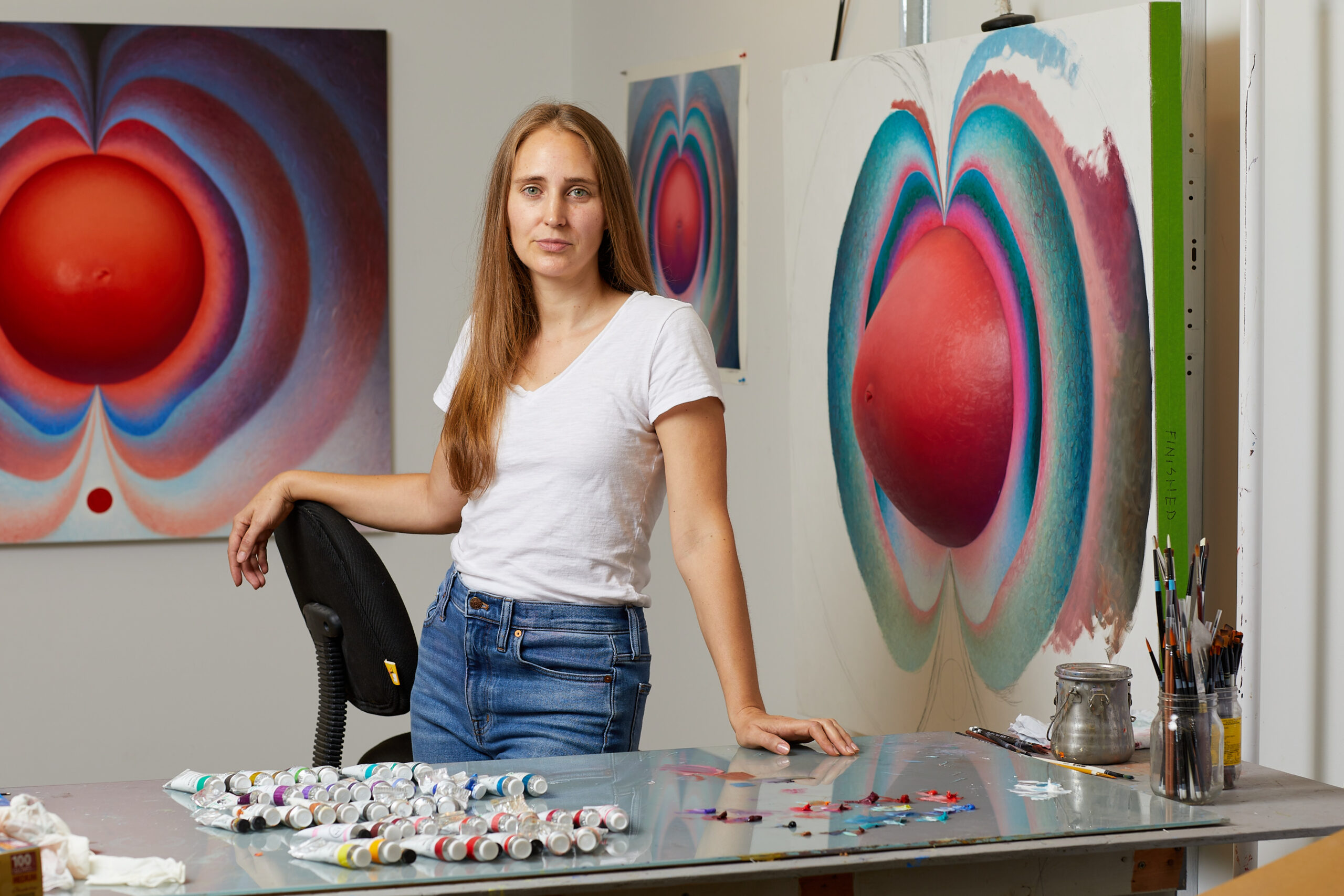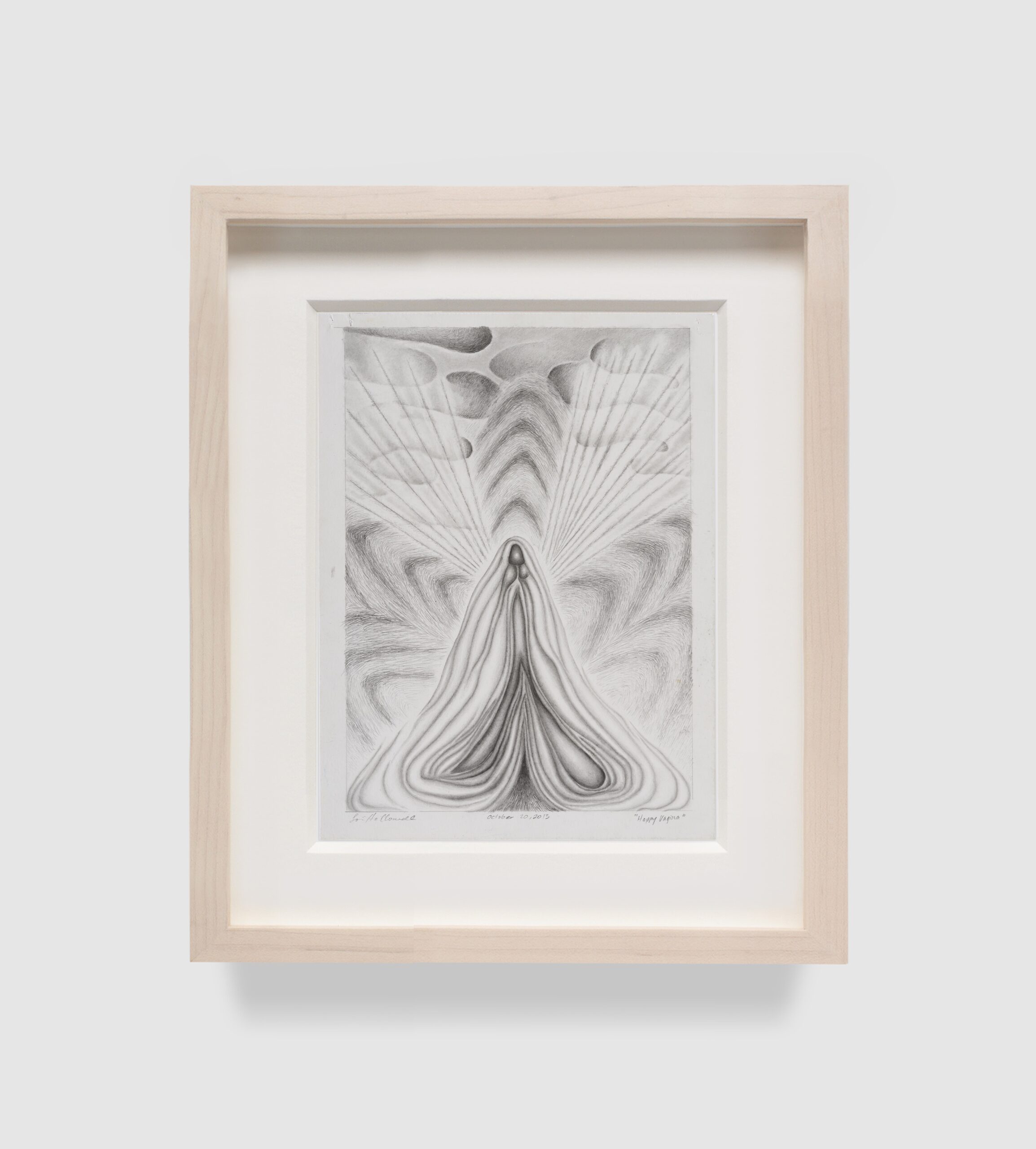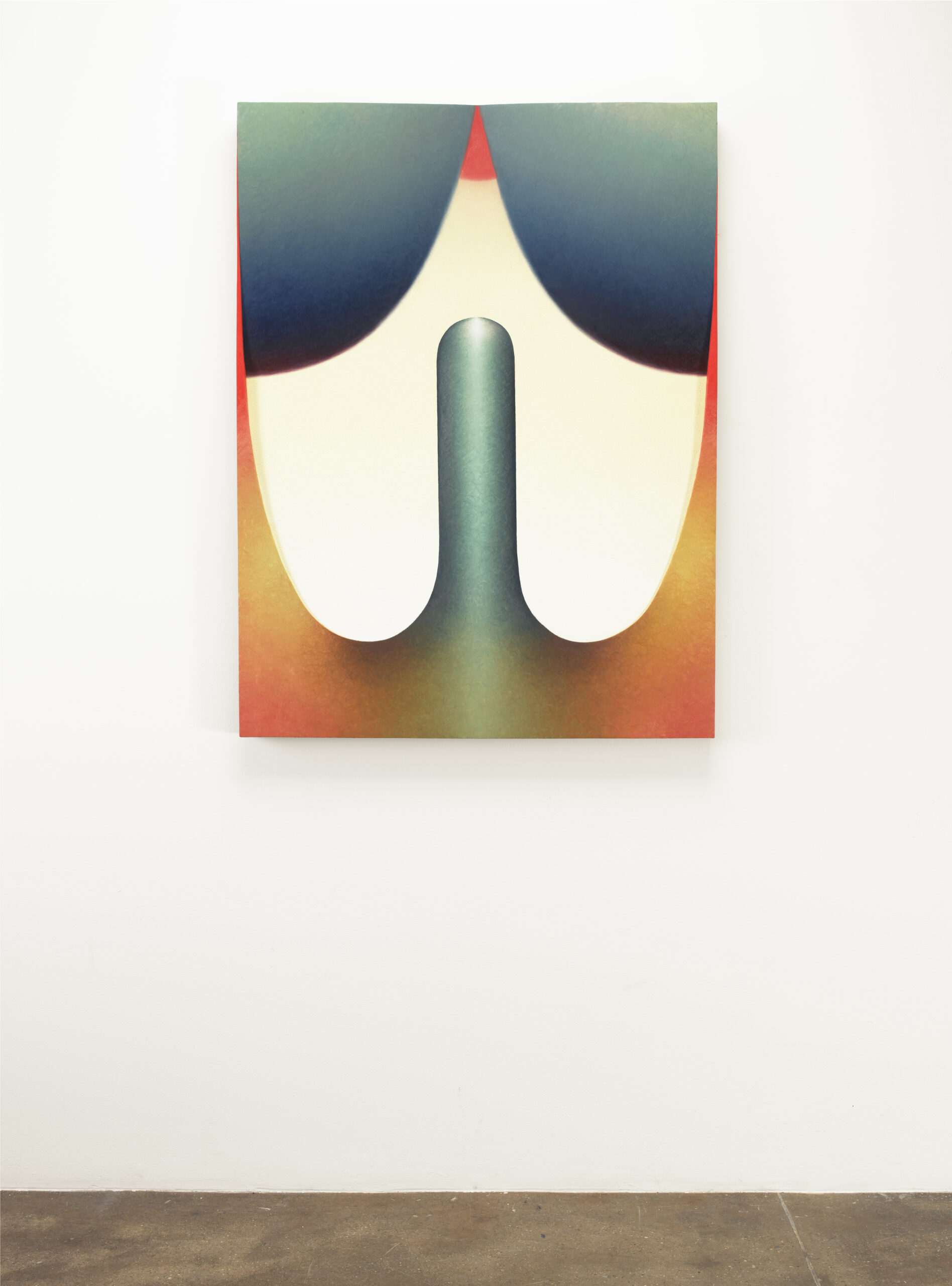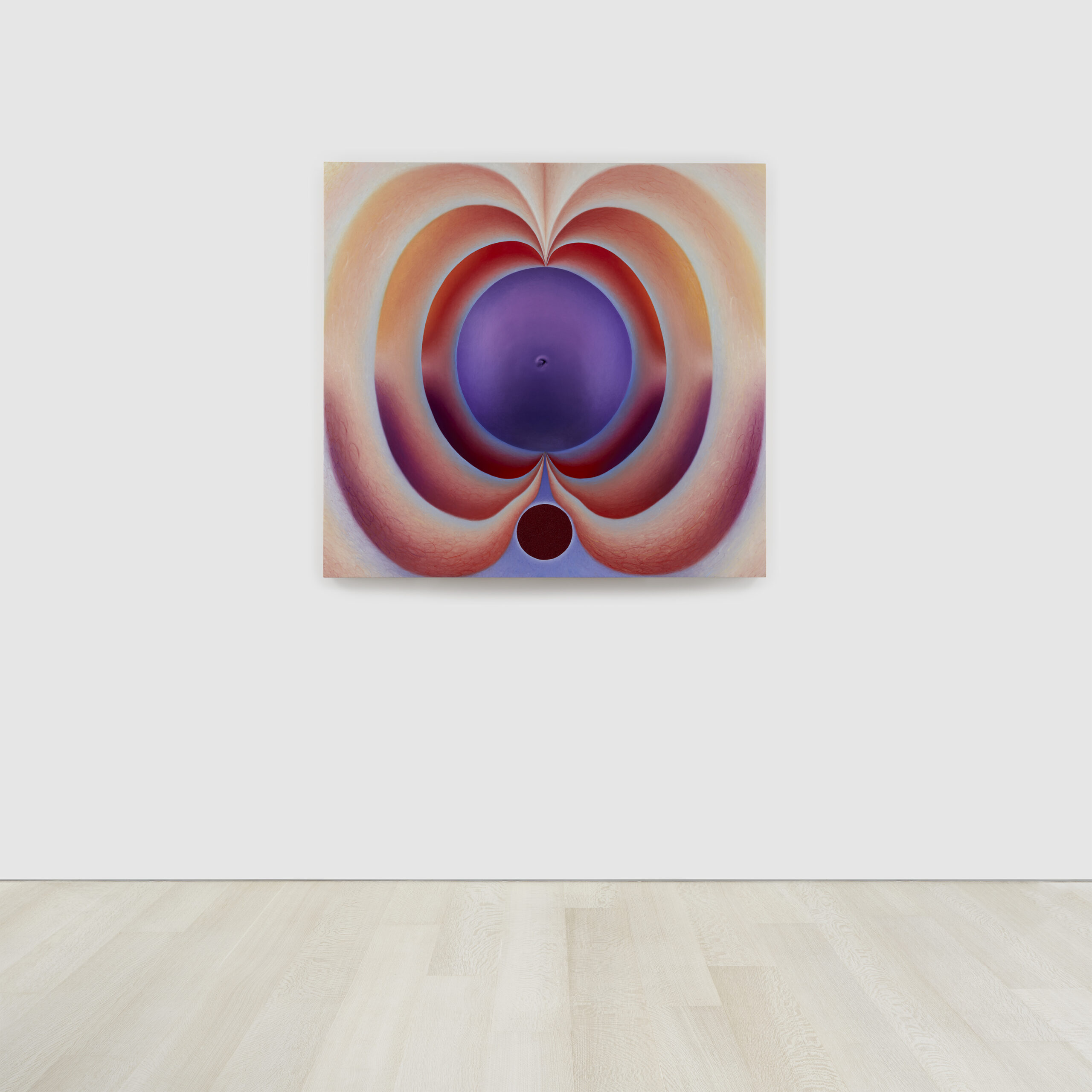STUDIO VISIT
Loie Hollowell on Frottage, Fantasy and Feminist Erotica

Loie Hollowell, photographed by Melissa Goodwin.
Loie Hollowell looks like Botticelli’s favorite model, who is depicted as Flora, the goddess of fecundity in his fifteenth-century masterpiece Spring, and then re-appears on the half-shell in his famed Birth of Venus. True to twenty-first-century feminist ideals, however, Hollowell poses for no one but herself. She also assumes perspectives that no one else could take, representing her sensuous physicality from the inside. Hollowell has a bright, clean studio on a quiet street in Queens NY, with areas for casting, priming, and painting her biomorphic wall works. Unofficially called the “Bellies,” the artist’s new series is formally titled “In Transition” as the painterly bas-relief wall works commemorate the penultimate stage of labor. Ten of them have just shipped to an exhibition at the San Francisco gallery of my wife, Jessica Silverman. When I met Hollowell, a lone belly titled Eight Centimeters Dilated remained on the wall as it was destined for her solo show at the Aldrich Contemporary Art Museum in Ridgefield, Connecticut. The retrospective, which opened January 21st and runs to August 11, 2024, features 19 paintings and 25 drawings, spanning the first decade of her mature career. On the occasion of the museum survey, Hollowell and I had fun talking about tits, asses, her artist father, her liberated mother, and women’s equal right to bodily autonomy.
———
SARAH THORNTON: I’m a huge fan of your work and I’m very excited by this early career retrospective at The Aldrich. It covers 10 years of work, including some work that I hadn’t seen before, like the earliest piece in the show from 2013, which is called Happy Vagina. Many things intrigued me about it, but the shocking thing is it’s in black and white. You are a phenomenal colorist, so can we talk about how you got there? How did the subjective experience of your body become the driving inspiration for your work?
LOIE HOLLOWELL: Well, I was just looking through my flat files as we were considering having work that spanned these full 10 years, and I came across these old drawings that I had made and I had forgotten about them. As soon as I saw Happy Vagina, my mind just zoomed back in time and place to when I made this work. It was in 2013, right after I had an abortion. It was so transformative and liberating that I had to make an image of the experience. Before this drawing I was making very cartoony, figurative portraits of plants and people. I hadn’t done anything in any form of abstraction or symmetry. I realized that Judy Chicago and Georgia O’Keefe, these pillars of beauty and innovation in the art world, two of the best American artists in all of history, could be the inspiration for this new venture into abstraction. So I started trying to formulate this experience of the abortion through the lens of their pictorial language. Happy Vagina is symmetrical, and that is in reference to my body. It is a self-portrait. And using the kind of liberating, visceral nature of Judy Chicago’s images, I thought it would be really important to give it this grounded structural power and let it emanate this light and chiaroscuro.

Happy Vagina. October 20, 2013. Graphite on paper. 12 x 9 inches. Collection of the artist. Photo: Melissa Goodwin, Courtesy of the artist and Pace Gallery.
THORNTON: I think when people look at the work, at first they may not think there’s any politics to it, but the driving force is highly political.
HOLLOWELL: The driving force is an abortion.
THORNTON: But overall, your oeuvre is about the validation of women’s bodies from their own perspective.
HOLLOWELL: Yes.
THORNTON: So it’s not about sexy bodies seen by men, it’s a refusal of the male gaze. It is very much about the subjective, sensual, tactile, bodily, visceral experience that women have of their own bodies. And of course, the adjunct to that is women’s bodily autonomy, which is such a contested issue in America and many parts of the world, it is implicit in every work you’ve made over the past decade.
HOLLOWELL: Yeah. I realized that I had an unlimited supply of narratives that would come just out of my own body, like I could be making interior self-portraits for the rest of my life. I could examine my prepubescent body if I wanted to go back in time. I then go through this experience of being able to get pregnant, thank god I’m able to have an abortion, that then transforms into me thinking about the potential of becoming a mother. And then I started a bunch of paintings with the fantasy of what it would be like to become a mother and made a bunch of sex paintings. I like thinking about my images as porn for myself. What kind of porn would I like, what would turn me on visually, not this kind of aggressive myopic porn of, what is it, Redtube?
THORNTON: xHamster, Pornhub.
HOLLOWELL: The question is, “What is the sensual, visual, phenomenological, experiential porn that gets me excited?” That has been a mission that I’m not necessarily going to talk about all the time, because I also like talking about the formal qualities of painting. But yes, in reality there is this political message of just body autonomy and the freedom to make the images that I want to make. Going back to Georgia O’Keefe and Judy Chicago, they really paved the way for allowing me to make these images that I can call pornographic.
THORNTON: Yeah. Feminist porn or erotica.
HOLLOWELL: Erotica, yes.
THORNTON: If we could skip forward, there’s a painting called Point of Entry from 2017. The subtitle is “Blue Green Mounds Over Yellow Sky.” It’s interesting to me that the goal of much of Judy Chicago’s early work, her biomorphic abstraction, is an answer to the question, “How can I depict the female orgasm?” The thing that strikes me about your work as soon as color enters is the sense of the orgasmic, a sense of elation.
HOLLOWELL: Yeah. When I started trying to abstract my body and my mental space around sexuality and femininity, my mission was to put it in the form of landscape. I think it’s interesting to make the perspective shifts that one would have in landscape, using the forms of the body. With Point of Entry, I was interested in having the butt, these curtain shapes at the top of the piece, be these heavy clouds in the foreground, and then you have this kind of phallic cactus shape coming in from below. And the space in between, this hazy yellow space, is both foreground and background. In each painting I really want to play with foreground and background. Each body part can be referential to many different things, so it’s almost modular in its reading.

Point of Entry (blue green mounds over yellow sky), 2017. Oil paint, acrylic medium, sawdust, and high-density foam on linen mounted on panel. 48 x 36 x 2½ inches. Courtesy of Carolina Zapf & John Josephson. Photo: Tom Barratt, Courtesy Pace Gallery.
THORNTON: It’s so interesting. One of the things I love about your work is the ambiguity around the biomorphic form. So what could be buttocks turns into a breast, which then turns into something internal.
HOLLOWELL: Exactly.
THORNTON: When I first glanced at this form, and I love it because I’ve just finished a book on boobs, I saw a titty fuck.
HOLLOWELL: That’s so funny.
THORNTON: So I was wondering if you can talk to me about the titty fuck.
HOLLOWELL: I’ve never made a painting of a titty fuck because I don’t have tits.
THORNTON: I’ve never given one either, but it is a thing. Frottage with a pair of, let’s say, ponderous jugs like these is very popular amongst some people.
HOLLOWELL: Well, that makes a lot of sense that you would know this, especially given your recent writing. For me, the image came out of my own phone images taken by my husband looking down at the pre-penetration moment, and I thought the beauty of this symmetrical form could be a really ripe space for an abstracted, compositional structure.
THORNTON: Although we’re talking about the work in very anatomical terms right now, as you said, the landscape element, the kind of alignment of stars and the sense of light, also make your work ethereal and celestial.
HOLLOWELL: Well, I want it to be for everyone. I don’t want to turn off certain viewers and I don’t need people to read all this sexuality into it. It can just read as a nice image to look at.
THORNTON: Before we leave the topic of sex, tell me about your mother. I’m under the impression that she was a liberated woman in terms of her relationship to her body.
HOLLOWELL: Yes. She is the most amazing woman. I actually forgot to confirm this with her, but I’m pretty sure she gave me a vibrator at the age of 18 because she knew I wasn’t experimenting enough. I was a very late bloomer, very focused on school.
THORNTON: She was concerned you weren’t having orgasms.
HOLLOWELL: And she was right.
THORNTON: You’ve got to love a mom like that.
HOLLOWELL: She was the mom that all my friends thought was the coolest. She was never hesitant to talk to us about our questions about our body. I mean, she had three girls, and finally my brother when she was 42, so she was breastfeeding for 10 years. She really knew her body.
THORNTON: She loved her own body?
HOLLOWELL: Oh yeah, she loves her body. My mom’s freedom with her ability to share her experiences and help us through our own navigations into womanhood was really what gave me the ability to deal with the content that I’m dealing with now. But my dad, who’s a painter, a very technical painter, spends about two years on one painting. He is a pointillist.
THORNTON: And hyperreal.
HOLLOWELL: A hyperrealist, pointillist painter. He gave me the drive to be in the studio for many hours at a time and spend the time it takes to make a painting. So the technicality that I bring to the work was brought by my dad, and the content, I would say, was given by my mom.
THORNTON: It’s a match made in heaven. I hate painting that looks like it lacks intention. I’m not that fond of accidents. The specific, skillful, highly accomplished craftsmanship, for lack of a better word, of your work, is a huge part of its beauty for me. And especially when you’re dealing with parts of the body that are associated with being too wet, too uncontrolled, the precision of your work is a wonderful ballast.
HOLLOWELL: It’s so funny, I haven’t really thought about this idea of precision much, but I do think of myself as a wrist painter. I’m not a gestural mark-maker, even if I’m making fairly large paintings, for me, a six-foot painting is massive. I’m using a fairly small brush and making swirling motions to blend things. It started with trying to mimic pubic hair, and now my main motion of blending is the swirling movement. I think it also has to do with my neurosis. I’m kind of a bipolar, neurotic person, and having something with a clear start and finish is very important for my mental wellbeing.
THORNTON: Well, it is not like you don’t know when the painting’s finished, or when the multimedia work is finished.
HOLLOWELL: It has a very clear finish, and kind of loosening up on that has taken having kids and just limited time to actually let me be a little more carefree with the preciseness of everything.
THORNTON: Personally, in the age of artificial intelligence, I think the body is the most important subject matter for art. I am very much convinced of this.
HOLLOWELL: Agreed, we’ve got to talk about tits. When did you start preparation for your book, Tits Up?
THORNTON: Well, I had a double mastectomy in 2018. And without thinking too much of it, I had reconstruction. I was lucky because I had ductal carcinoma in situ, I did not have full-blown cancer. I just had a lot of pre-cancer, a lot of rogue atypical cells. I feel like I dodged a bullet. So afterwards, these silicon orbs, I called them Bert and Ernie, I felt really alienated from them. They were too big, they were too round, they were dumb, they lacked sentience, they didn’t have warmth, they didn’t have sensation. I really had a sense of loss. So then I just started reading everything I could get my hands on. And that’s how I started the book.
HOLLOWELL: Wow.
THORNTON: That’s why I relish your work so much, because you are an investigator of the body. And I love your dealing with lactation, because lactation is the reason we exist as we do. Breastfeeding is the origin of sociality, it’s the origin of love. An infant has to make you love it in order to survive. This is something that’s underrepresented in the history of the evolution of our species.
HOLLOWELL: Under-studied.
THORNTON: Totally under-studied.
HOLLOWELL: And under-appreciated.
THORNTON: And omitted. There are so many histories of homo sapiens that actually don’t mention breasts. And i’m like, “How is that possible?”
HOLLOWELL: I didn’t do much research into it beforehand, but as soon as I started breastfeeding, all of my friends came to my aid and shared their own stories, and all their memories were re-sparked. We forget all of this pain so quickly as a survival trait, women as birthers, we forget all the pain.
THORNTON: We have to talk about the new belly works, because I am totally in love with them. How did you come to start them? They are divine and sublime.
HOLLOWELL: Thank you, Sarah. The composition really started with the series of paintings in which there are two orbs that are split open and there’s radiating color energy lines that come out. I started that series again after my first birth. With the second I had a home birth, and it was such a mind-bending experience, giving birth in my bedroom in a bathtub. The connection I had with my body was so much greater than it had been in the hospital and I was really able to experience the physicality on a whole new level. And so, from the split orbs, I decided I needed to actually take that pregnant belly and make it the physical thing from which the energy radiates. I think of those paintings as impregnated. Behind this form is a baby, there is a little fetus sitting inside each painting, ready to come out.
THORNTON: It’s the dawn of a new consciousness.
HOLLOWELL: Yes. The energy coming out was trying to formulate a color space for each of those series of contractions I had as I moved through the labor. So at eight centimeters dilated, as I remember the experiences, this was my visualization of that time. Eight centimeters, you’re almost all the way dilated, almost at the point at which you start pushing out the baby, and it’s extremely painful. The contractions are very intense. So I just wanted the colors that radiate from the belly orb to express that intensity.
THORNTON: It’s interesting, I didn’t know that you gave birth in a bathtub. I can see the mound emerging from the water. There is that sense of the plane, perhaps where the water picture was?

Eight Centimeters Dilated in purple, blue, red and yellow, 2023. Oil, acrylic medium, aqua resin, epoxy resin, on linen over panel. 45 x 48 inches. Courtesy of the artist and Pace Gallery. Photo: Melissa Goodwin, Courtesy Pace Gallery.
HOLLOWELL: Mm-hmm.
THORNTON: Although in general, the feeling of outer space supersedes the sense of being in water. Both are evoked by this celestial halo or this radiating out, like when you throw a stone in the water and it ripples.
HOLLOWELL: Well, I come to it from that space, too. When I was giving birth in the tub, in between contractions, I was visualizing myself from above. I had my two midwives there and my Doula and my husband and my son, and everyone was looking at me from above. And I was looking at myself in this very brief time of rest. I wanted to bring that into the painting, that sense of being both outside the body and then instantly sucked back into yourself, instantly sucked back into your vagina, with the intense pain.
THORNTON: On that note, the expanding and contracting of birth is also the expanding and contracting of orgasm. And so we’ve gone full circle back to the beginning of our conversation. And I thank you so much for your brave and beautiful work.
HOLLOWELL: Thank you so much for your brave and beautiful writing. I cannot wait to get Tits Up, I’ve already pre-ordered. I love the cover design.
THORNTON: You are so kind. The love fest will continue another day.






